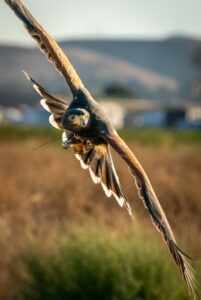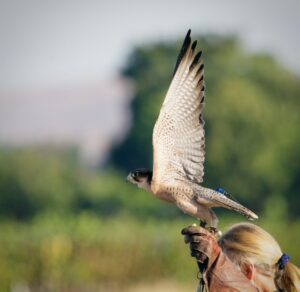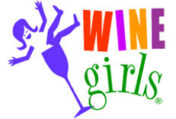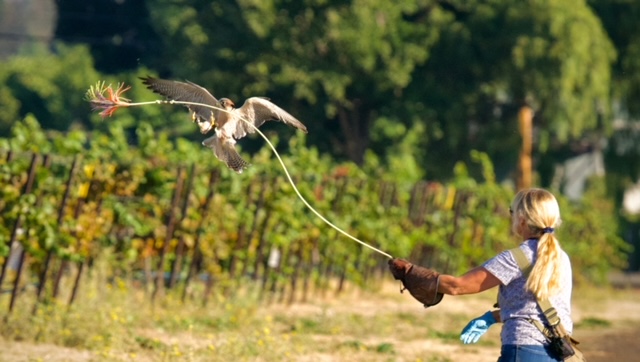Do you get a tingle of excitement when you see wine grapes getting riper each day? Not only do we Winegirls get excited, but birds such as starlings, robins, finches, blackbirds, and others get excited: they can’t wait to poke their beaks into a juicy, sweet grape to pluck out the seeds. This damages the fruit, reduces what’s left for harvest, and puts the remaining crop at risk of disease and insect pests. That’s when Jana Barkley, Master Falconer and “Pest Bird Abatement” licensed professional, comes to the rescue. We interviewed Jana and learned more about her important work.
Jana Barkley uses predatory birds, her captive-bred falcons and hawks, to scare away the smaller birds from her client’s grape vines. You may have seen vineyards use several different methods to repel pest birds, such as draping nets over the vines, attaching kites and streamers to the vines, or using light lasers. Some vintners may apply chemical bird repellant to their grapes. But there is something very primal and natural about using the hunting and harassing instincts of predatory birds to solve this problem. And more and more wineries are adopting this approach.
WG: What is it that you and your falcons do in vineyards?
JB: We do something called Pest Bird Abatement using Falconry, with both falcons and hawks. Falconry is a hunting sport. To become a Falconer, you go through an apprenticeship to learn to hunt with your trained bird of prey. After you do that for 7 years, you’re considered a Master Falconer, and at that point, you can apply for a special purpose permit from the federal government to do what we call Falconry Pest Bird Abatement. Our goal is to harass the pest birds, to get them to fly away.
Starlings are the number 1 nemesis. They are not native, but other pest birds such as house finches and mountain bluebirds are native, and it is illegal to harass the native birds unless you have the permit that I have. So, we get called in by the vintner around the time of veraison (the start of grape ripening) to create a predatory presence in the vineyard to scare the birds off, sunrise to sunset, for 9-10 weeks through the final harvest.
WG: So how does this work? What does your typical day in the vineyard look like?
JB: The vineyard will give us a place to set up camp and a fenced-in area to give the falcons and hawks a weathering area (a place to rest on their perches). Then each day we get up around 7 am, load up my dog and the birds I’m using that day, and head out to the vineyards to start working. I will send my dog down a vineyard row to flush out birds, and then I will put a falcon up. Just having that predator bird up there is enough to scare the little birds off. The starlings absolutely hate the falcons. We will cover 1000 acres a day doing this every day. It’s long, and it’s grueling, we don’t take weekends off because the birds don’t, but it’s also fun. Over the weeks we are out there you really see the birds’ fitness level develop. They become little flying rockets by the time harvest is over and we pack up to go home.

Cowboy, Jana Barkley’s Harris Hawk on patrol. Photo credit: Michael Pociecha.
WG: How many birds do you work with each day?
JB: I have 8 birds, 4 hawks and 4 falcons. 7 of the birds come with me to the vineyard, and 1 is now retired. We rotate them out, flying sometimes 2-3 birds each day. We go from field to field, and often circle back around because the pest birds will come back.
WG: How long are the falcons and hawks flying at a time?
JB: They hunt differently. Hawks are more leisurely hunters and tend to hunt things on the ground. The falcons are aerial hunters and tend to attack things up in the sky, like an arrow. When a falcon goes up it could be two, three up to 10 minutes a time, depending on what’s going on. When a Falcon is up, it is scaring the birds in the sky; the hawk on my glove will fly low to scare birds who are lower down.

WG: How long have you been working in the vineyards?
JB: This is my 6th year working in the vineyards. I’ve worked during dry years, in fire years when there was a lot of smoke, and in years when it was very, very wet. This past year was cold and wet, and the season went longer.
WG: How did you get into this work?
JB: I became a Falconer 20 years ago. I was in another profession living in the Bay Area and went to the Pleasanton Scottish Games. They had the hunting hawks there and the state Falconry club there and it just grabbed me. So, I got involved and became a falconer. A good friend finished up her apprenticeship after me, and she and I would go out and hunt together. Then in 2011 I moved up to Yuba County to help another friend who started up a Falconry Center, where people could come up to have a Falconry experience, much like they do in Ireland and England. I was there for 7+ years. I realized it was time to go out on my own, so I started my abatement business in 2017. As luck would have it, a friend connected me to Phil Wente of Wente Vineyards who had a falconry program. I submitted a bid, we clicked, and I have been with Wente Vineyards ever since.
WG: How do you select birds for your abatement services?
JB: Any birds that you use in Falconry can be used: falcons, hawks, even owls, except for wild-caught birds. The law states that in abatement falconry we can only use captive-bred birds, so that rules out wild-caught Red Tail Hawk or Coopers Hawk that some of us use in hunting falconry. These birds are usually only with us for a short time to get healthy and then released to the wild to find a mate and breed.
WG: When harvest season is over, what do your birds do the rest of the year? Do they get bored?
JB: (laughs) No, usually that’s mid-Fall, crow season up where I live. Nat Geo did a special and we have the largest population of crows in the world that time of year. It can be like the movie “The Birds”. My clients hire me to bring a predatory presence to keep the crows away. I also have clients who have a need to keep doves and pigeons away, so there’s lots of work for us. But the vineyards are probably our favorite.
So next time you visit a vineyard near harvest time, look up in the sky. You might be lucky enough to see some falconry birds at work with Master Falconer Jana Barkley, making sure the grapes end up in our wine glasses. Cheers!
Learn more at aero-falconry.com

